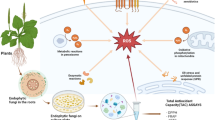Abstract
Air-born mixed fungal and bacterial culture capable of complete degradation of ciliatine was isolated. The utilization of the natural organophosphonate proceeded in the phosphate independent manner. Enzymatic activity involved in ciliatine degradation studied in the fungal cell-free extract proved to be distinct from bacterial pathway described before.
Similar content being viewed by others
References
Adosinda M, Martins M, Ferreira IC, Santos IM, Queiroz MJ, Lima N (2001) Biodegradation of bioaccessible textile azo dyes by Phanerochaete chrysosporium. J␣Biotechnol 89:91–98
Bending GD, Friloux M, Walker A (2002) Degradation of contrasting pesticides by white rot fungi and its relationship with ligninolytic potential. FEMS Microbiol Lett 212:59–63
Bode R, Birnbaum D (1989) Specificity of glyphosate action in Candida maltosa. Biochem Physiol Pflanzen 184:163–170
Bradford MM (1976) A rapid and sensitive method of the quantitation of microgram quantities of protein utilizing the principle of protein-dye binding. Anal Biochem 72:248–254
Bujacz B, Wieczorek P, Krzyśko-Łupicka T, Gołąb Z, Lejczak B, Kafarski P (1995) Organophosphonate utilization by the wild-type strain of Penicillium notatum. Appl Environ Microbiol 61:2905–2910
Cook AM, Daughton CG, Alexander M (1978) Phosphonate utilization by bacteria. J Bacteriol 133:85–90
Fiske CH, SubbaRow Y (1925) The colorimetric determination of phosphorus. J Biol Chem 66:375–400
Kawai S, Uno B, Tomita M (1991) Determination of glyphosate and its major metabolite aminomethylphosphonic acid by high-performance liquid chromatography after derivatization with p-toluenesulphonyl chloride. J Chromatogr 540:411–415
Kononova SV, Nesmeyanova MA (2001) Phosphonates and their degradation by microorganisms. Biochemistry (Moscow) 67:184–195
Krzyśko-Łupicka T, Strof W, Kubś K, Skorupa M, Wieczorek P, Lejczak B, Kafarski P (1997) The ability of soil-borne fungi to degrade organophosphonate carbon-to-phosphorus bonds. Appl Microbiol Biotechnol 48:549–552
Nowack B (2003) Environmental chemistry of phosphonic acids. In: Valsami-Jones E (ed) Phosphorus in environmental technology: principles and applications. IWA Publishing, pp 147–173
Olsen DB, Hepburn TW, Lee S, Martin BM, Mariano PS, Dunaway-Mariano D (1992) Investigation of the substrate binding and catalytic groups of the C–P cleaving enzyme, phosphonoacetaldehyde hydrolase. Arch Biochem Biophys 296:144–151
Sobera M, Wieczorek P, Lejczak B, Kafarski P (1997) Organophosphonate utilization by the wild-type strain of Cladosporium resinae. Toxicol Environ Chem 61:229–235
Ternan NG, McMullan G (2000) The utilization of 4-aminobutylphosphonate as sole nitrogen source by a strain of Kluveromyces fragilis. FEMS Microbiol Lett 184:237–240
Torsvik V, Øvreås L (2002) Microbial diversity and function in soil: from genes to ecosystems. Curr Opin Microbiol 5:240–245
Wanner BL (1996) Phosphorus assimilation and control of the phosphate regulon In: Neidhardt FC, Curtis RI, Gross CA, Ingraham JL, Lin ECC, Low KB Jr, Magasanic B, Reznikoff W, Schaechter M, Umbarger HE, Riley M (eds) Escherichia coli and Salmonella: cellular and molecular biology, 2nd ed. American Society of Microbiology, Washington, pp 1357–1381
Watanabe K, Hamamura N (2003) Molecular and physiological approaches to understanding the ecology of␣pollutant degradation. Curr Opin Biotechnol 14:289–295
Weiland M, Daro A, David C (1995) Biodegradation of thermally oxidized polyethylene. Polym Degrad Stabil 48:275–289
Zboińska E, Maliszewska I, Lejczak B, Kafarski P (1992) Degradation of organophosphonates by Penicillium citrinum. Lett Appl Microbiol 15:269–272
Acknowledgements
This work was supported by Ministry of Education and Science, Grant 2 P04B 001 28.
Author information
Authors and Affiliations
Corresponding author
Rights and permissions
About this article
Cite this article
Klimek-Ochab, M., Obojska, A., Picco, A.M. et al. Isolation and Characterization of two New Microbial Strains Capable of Degradation of the Naturally Occurring Organophosphonate––Ciliatine. Biodegradation 18, 223–231 (2007). https://doi.org/10.1007/s10532-006-9057-7
Received:
Accepted:
Published:
Issue Date:
DOI: https://doi.org/10.1007/s10532-006-9057-7




